
It was my first time in Bosnia and Herzegovina and I was so excited to get dug into exploring Sarajevo, the incredible capital city on the Miljacka River at the heart of this fascinating country.
Sarajevo has been the centre of some pretty mega events throughout history and it was truly awe-inspiring to walk through the streets where the 1914 assassination of the Austro-Hungarian Archduke Franz Ferdinand and his wife Sofia occurred, leading to World War I, and the heavy and harsh recent genocide of the 90s that saw the end of Yugoslavia.
Yugoslavia was a kingdom then a federation of six nations from 1918 to 1992, between the end of WWI and the genocide. The six nations included Bosnia and Herzegovina, Croatia, Macedonia, Montenegro, Serbia and Slovenia.
Sarajevo sits sort of at the heart of it all. Notably having been part of once both the Ottoman Empire and the Austro-Hungarian Empire, the city reflects these vibes very clearly. The east-meets-west is so clear that even a line has been drawn on a street to symbolise where the European influence becomes a Turkish influence. I felt very much like I was walking through Vienna one moment and Istanbul the next.
Sarajevo is in the southwestern part of Bosnia and Herzegovina. It is well-connected to all other cities across the Balkans.
By bus: I arrived by bus from Belgrade in Serbia, which took about seven hours. Just note that the bus station is actually in east Sarajevo, about half an hour away by bus from central Sarajevo. From the bus station, the local bus 103 runs straight into the city centre.
→ Check out my complete guide to visiting Belgrade!

Sarajevo Railway Station
By train: I left Sarajevo by train down to Mostar. The Sarajevo railway station is just three stops on tram 2 or 3 from the centre of Sarajevo. Book train tickets for Bosnia and Herzegovina on the Railway Federation site; they're quite affordable!
→ Check out my complete guide to visiting Mostar!
By flight: Flights arrive at Sarajevo International Airport; from there you can take the Centrotrans airport shuttle which takes about half an hour into the city.
By car: You can travel through the Balkans with your own car, as well. I don't have any experience with this but the streets are well-maintained and there seemed to be plenty of parking, but please do your own research here.
→ If you don't have your own car, you can rent one in Sarajevo.
Sarajevo is a super walkable city. Everything on the "must-see" tourist lists is in walking distance and you’ll find yourself navigating the streets with ease.
You might also want to join a walking tour of Sarajevo to get a really good insight from a local of the history and learn a bit more about the town.
If you're transfering to either the East Sarajevo Bus Station or the Sarajevo Railway Station to head in or out of the city, you can take local buses and trams.

The tram

Walking around Sarajevo by day

and by night!
I am staying in hostels for this Balkan trip. In Sarajevo, the absolute best hostel to stay at is Igor's The Good Place Hostel. Igor has converted his old family home into a fun backpacker hostel situated right on Sarajevo's main street and with a huge balcony overlooking it. Comfy beds with curtains, free coffee and tea, great owner and a really good vibe? I can highly recommend this one.
→ Book your stay at The Good Place Hostel.
→ Check out other places to stay to suit your budget and accommmodation type.

Image via Booking.com
Sač
On the top of the list for things to eat in Sarajevo, you absolutely must go to Sač. They serve up the best burek I've ever had in four simple flavours - spinach, potato, cheese and meat. I tried all three of the vegetarian kind and can confirm: best ever.



Baklava Dućan
Our walking tour guide said that another must-try in Sarajevo is baklava, and apparently (although I didn't get a chance to try myself), Baklava Dućan is the best spot in town.

Smutihana
On hot summer days in the city, I can highly recommend the delicious smoothie combos at Smutihana.
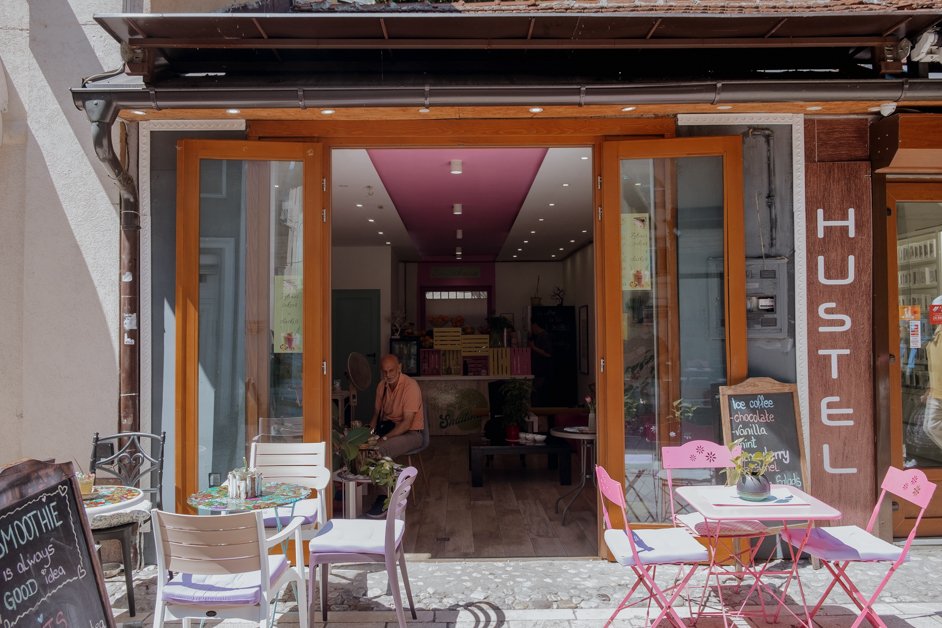
One of my favourite ways to see a new city is to start with a free (well, by donation) walking tour to get to the lay of the land and learn the history. That way, you can see all the highlights, and then decide what you want to go back and see more of. Usually, these tour guides are locals and are fonts of knowledge, and can also give great recommendations for museums, food and other further activities depending on what you’re interested in.
I really enjoyed our Sarajevo walking tour - our guide was really funny and told us all about Sarajevo in an engaging and fun manner.
Here is what I saw during my stay in Sarajevo:
Baščaršija and Sebilj
The main square in Sarajevo, Baščaršija is the heart of the city and the old bazaar and bustling market. You can shop and dine here and it very much felt like shopping and dining in Istanbul. In the centre of the market is the Sebilj, a fountain and one of most well-known icons of the city.





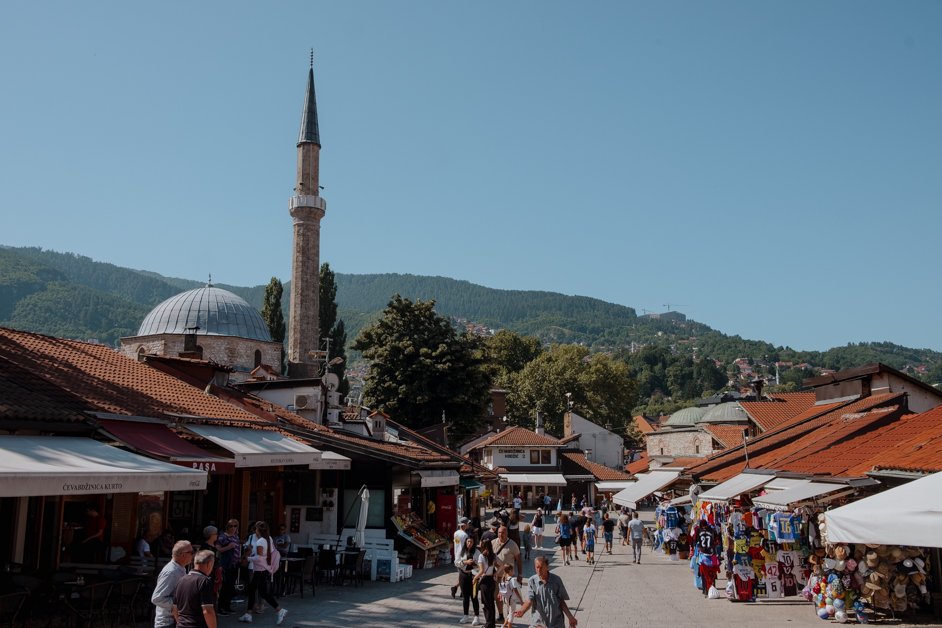





Miljacka River
The Miljacka River flows through Sarajevo, with the northern "Bistrik" side, meaning damp, and the southern "Vratnik" side, meaning sunny. There are plenty of bridges built nowadays that cross the Miljacka; the most famous one is next on this list.





Latin Bridge and the Assassination of Archduke Franz Ferdinand in 1914
It was at the end of the Latin Bridge where Gavrilo Princip stood in 1914 on the day of Archduke Franz Ferdinand's visit to Sarajevo with his wife Sofia in 1914 and fired the fatal shots that killed them both, sparking World War I. Today, you can see the exact spot he stood as well as the exact location of the car that the Archduke and his wife were riding in upon their death. There is a small museum here now telling the story.






The exact spot Princip stood

You can see where the four wheels of the Archduke's car were
Museums of Crimes Against Humanity and Genocide
The Museum of Crimes Against Humanity and Genocide is a collection of heart-wrenching personal stories from the genocide of the 90s that occured across former Yugoslavia. It is not your typical museum and does not present a timeline of the genocide as such, but really focuses on the personal anecdotes of those who lived through these horrific times and continue to do so.
Be prepared, it is heavy and very visual, and probbaly not suitable for younger audiences. At the time of writing, tickets were 18 KM (about €9) and could be purchased on site.

Tašlihan
Built in the 1500s as an inn for traveling merchants and their caravans, some of the ancient ruins have been preserved and a bustling market still stands on the original site. It reminded me of Istanbul's Grand Bazaar!

Sunset at the Yellow Fortress
The Yellow Fortress, visible from the city below, in a cannon fortress built between 1727 and 1739 serving as a defense point for the Austro-Hungarian Army. It is hands down the best spot in the whole city to watch the sunset over Sarajevo.







Kazandžiluk Copper Street
Just off the main square in Sarajevo, this street is filled with copper shops, many still owned by the same families since the 16th century. Copper is easily pliable so it can be used to make products quickly and simply.
Perhaps it is quite touristy, but we visited as part of our walking tour and I enjoyed watching the demonstration of how a bookmark is made by hand - I purchased a small one for the many books I am trying to read this year.

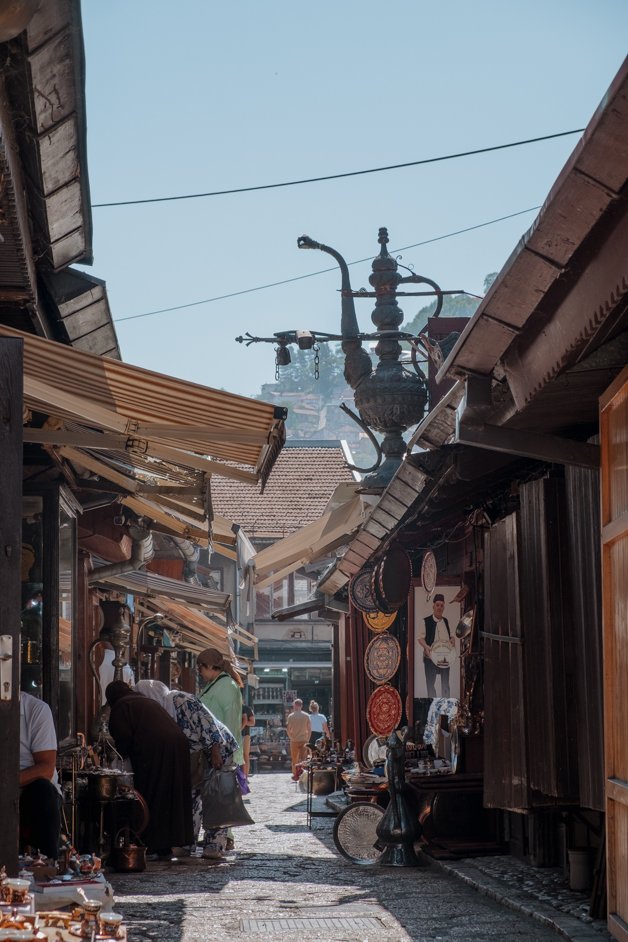



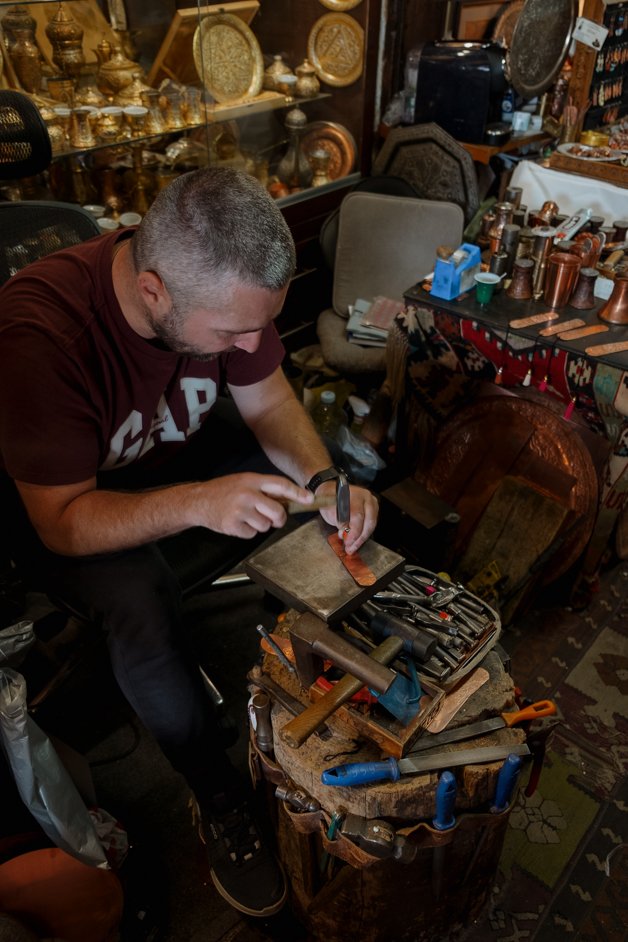
Sacred Heart Cathedral
Built in 1889, this is the largest cathedral in Bosnia and Herzegovina, and the seat of Archbishop of Vrhbosna. I didn't go inside, but poignantly you can still see bullet holes in the outer walls from the 90s genocide, as well as a a spot right out front where a missile fell killing multiple people; it has been painted red in memory and is called Sarajevo's Rose.
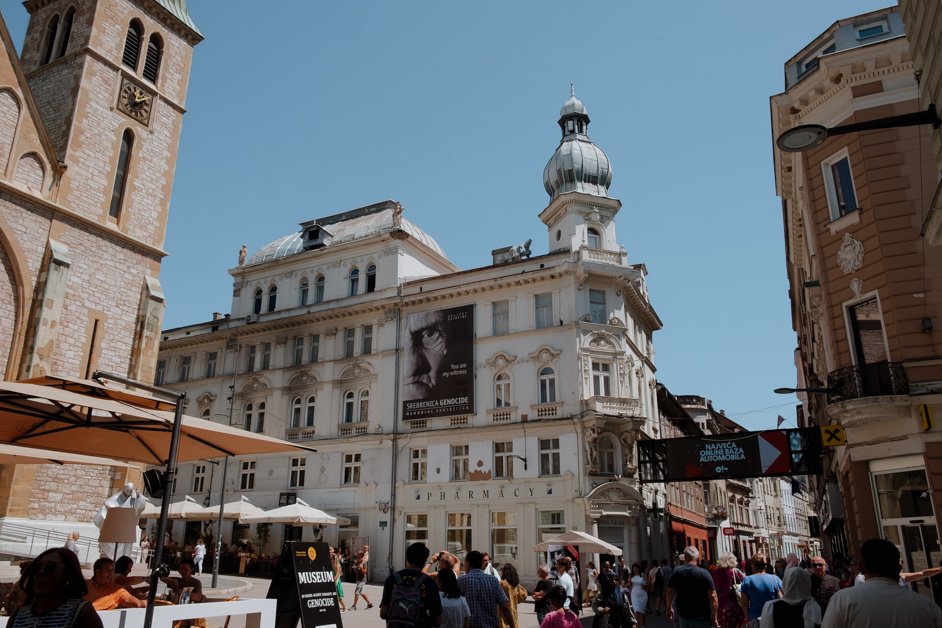



Where a missile fell outside the cathedral, painted red in memory

View from the steps of the Cathedral
City Hall
The well-known city hall stands on the banks of the river. It is designed in Moorish architecture, and sticks out like a bit of a sore thumb against the backdrop of Sarajevo.
The Archduke Franz Ferdinand and his wife Sophie had attended a reception here right before they left in their motorcar where they were shot at the Latin Bridge. City Hall later became a library in 1949, but the 1992 Siege of Sarajevo saw the library completely destroyed including much of its valuable collection. The reconstruction lasted from 1996 to 2013 to look exactly the way it was pre-war, costing Austria and the EU about 25 million KM (about €13 million).

Gazi Husrev-beg Mosque
Named after a former governor of Sarajevo, Gazi Husrev-beg Mosque is the largest mosque in Bosnia and Herzegovina, built in the 16th century. If you wish to visit, you must go outside of prayer times and be appropriately dressed (women - cover hair, shoulders and knees; men - cover shoulders and knees).



Bookstore Connectum
I loved wandering through the little multi-storied Bookstore Connectum that has plenty of English books on offer, plus many good books on the history of Sarajevo and Bosnia and Herzegovina.

Ćurčiluk veliki
This pretty street is where the bookstore and the Smutihana (smoothie shop) are both located and it's just a sweet little shopping street to wander down and with a beautiful view of the mosque at the end.



Sarajevo Cable Car
The best for last - I really enjoyed the ride up Sarajevo's famous cable car. This ten-minute ride takes you slowly high above the city for seriously incredible views of Sarajevo nestled below surrounded by the Dinaric Alps.
The first cable car, Trebević, was opened in 1959, but destroyed in 1992. In 2018, the current cable car was reopened. Tickets do not need to be bought in advance, you can buy them for 30 KM return upon arrival. The view from the top is beautiful, a cafe is available on site and, if I'd had more time, I would have walked the remnants of the Olympic Boblsed Track.








BOOK AN EXPERIENCE IN SARAJEVO!
PIN THIS POST TO REFER BACK TO LATER!


GET READY TO TRAVEL!
— Book tours and experiences - with GetYourGuide
— Get all the gear you need for your trip - with Amazon (North America)
— Get all the gear you need for your trip - with Amazon (Europe)
— Find a place to stay - with Booking.com
— Choose a hostel to stay at - with Hostelworld
— Purchase global travel insurance - with World Nomads
— Load an international eSim on your phone - with AirAlo
— Start your own travel blog - with Hostinger
— Join the GetYourGuide Travel Creator Community - with GetYourGuide
Hi! I’m Jana, a Dutch-German-British-Canadian with a dream of seeing every country in the world. I am a storyteller, photographer and adventurer passionate about documenting and sharing my travels.
